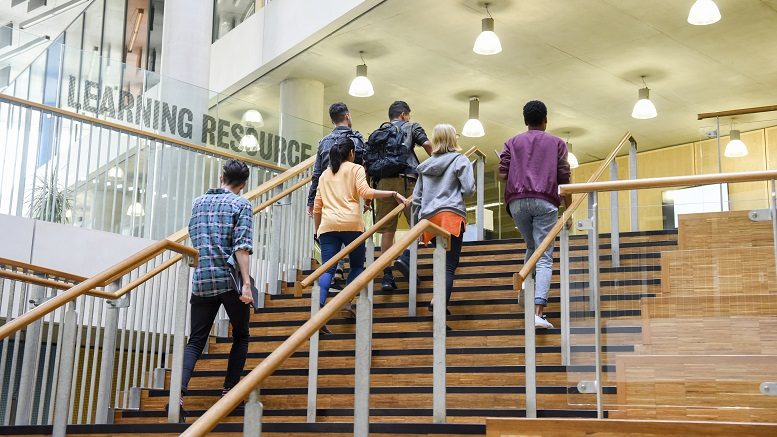With Covid-19 vaccines more widely available and case counts and hospitalizations declining, community college administrators, faculty and students are preparing for the fall 2021 semester.

The last academic year brought many changes. Institutions were forced to pivot to online learning, enrollment declined and administrators were required to implement new Covid-19 safety protocols. It was a challenging environment, but educators, students, and administrators rose to the challenge. They navigated the situation as best they could, and I’m proud of what I’ve seen at higher education institutions across the country.
While it is impossible to predict what the future of the pandemic will hold, we know that education in the 2021-2022 academic year will look markedly different than it did in any prior year. As many students who dropped out or delayed plans to pursue higher education return to the classroom, community colleges have a chance to offer a truly valuable experience to students that will empower them to reach even higher levels of success.
Doing so will require administrators and educators to adopt new mindsets, tools and approaches to best serve students in this new environment. Before the semester begins, there are a few steps community colleges can take today to prepare for a “new normal” in the fall of 2021.
Prioritize remote learning by making it simple, easy and accessible to all students
Covid-19 accelerated the adoption of remote learning, which is one product of the pandemic that is here to stay. Many college students were very happy with their remote classes over the past year. One survey of college students found that 84% believe remote learning environments can be effective and 70% would consider taking more virtual classes in the future. Remote learning allows our educators to broaden their reach to students who have a hard time traveling to campus. Additionally, it provides another layer of flexibility to busy students who may be working or taking care of loved ones at home.
Many institutions have already gone through the difficult task of setting up remote learning capabilities and training their professors. As we move forward, colleges should continue to lean into remote learning capabilities by making them even easier to access and simpler to use. Doing so will allow educators to help more students stay on track and pursue their academic goals from anywhere.
Offer free and easily accessible mental health support to all students
The pandemic has taken a significant toll on the mental health of college students. A recent study by BestColleges.com found that 95% of surveyed college students reported negative mental health symptoms during the pandemic – 48% of those students said it directly affected their education. Additionally, almost half of respondents reported feeling more isolated, 40% slept less, 39% exercised less and ate worse, and 32% experienced feelings of hopelessness.
These mental health issues must be addressed for students to reach their fullest potential. Thankfully, there are many ways colleges can help. While nothing new, talk therapy with licensed professionals is one treatment method that can make a tremendous positive impact on those who require mental health support. College guidance counseling offices are a great place to start, but many students simply fail to recognize or take advantage of these services. Innovative new online therapy providers, such as TalkSpace and Betterhelp, provide a way for college campuses to expand student access to talk therapy. At Montgomery County Community College, we decided to make access to these services free for every student, and have already witnessed its positive impact on their mental health.
Commit to diversity and inclusiveness
The protests and civil unrest of 2020 shined a light on the fact that the U.S. has a long way to go in addressing inequality. Community colleges are uniquely positioned to help level the playing field by providing higher education opportunities to people of color, the LGBTQ+ community, individuals of all abilities, and students of all socio-economic backgrounds.
The pandemic took us to where students lived and not all were situated similarly to take advantage of remote access in terms of computers, internet connectivity, and even computer literacy. As our open-access institutions witness the demographic shifts in student populations consistent with national trends, we have to be prepared to receive and relate to students of different lived experiences and backgrounds and to help them to belong and thrive in their educational pursuits.
This effort starts by making campuses more inviting and accessible to all individuals, which requires a shift in mindset and a dedicated financial investment. Write out an inclusivity action plan and commit to evaluating results and tweaking efforts each year. Provide diversity and inclusion training to every employee, top to bottom, to ensure the commitment to inclusion is felt across the entire institution. Create focus groups with minority populations on campus and commit to learning new opportunities to improve inclusiveness efforts. Committing to inclusivity is an ongoing effort and must be built into a college’s mission and reevaluated on a continued basis.
Help students build skills that meet local business needs
Even before the pandemic, employers were hiring more community college graduates than ever before. In the last six months of 2019, the number of employed Americans with an associate degree rose by 578,000 people, compared to just 314,000 Americans with a four-year degree. This trend will likely continue as many expect the need to fill positions in STEM, technology support, and health and wellness, many of which require an associate degree, will grow after the pandemic.
With the business and employment landscape shifting, community colleges must remain nimble and provide students with opportunities to learn new skills fit for a post-Covid economy. They can start by building close connections to local businesses to gain a sense of their employment priorities and needs. From there, community colleges can create job placement programs and internship initiatives to set up students with the skills needed to launch successful careers in their local communities immediately after graduation.
A driving force for positive change
With the pandemic winding down, local residents will lean on community colleges more than ever before as we rebuild for a brighter future. By enhancing remote learning, prioritizing student mental health, committing to inclusiveness, and helping students build new skills, community colleges face an opportunity to serve as a pivotal driving force that transforms our communities for the better. It is essential that administrators and educators not delay. By making these powerful changes to our institutions today, we can help students elevate their lives in ways never before thought possible and improve the communities we serve through strengthening the workforce and bolstering economic recovery.

